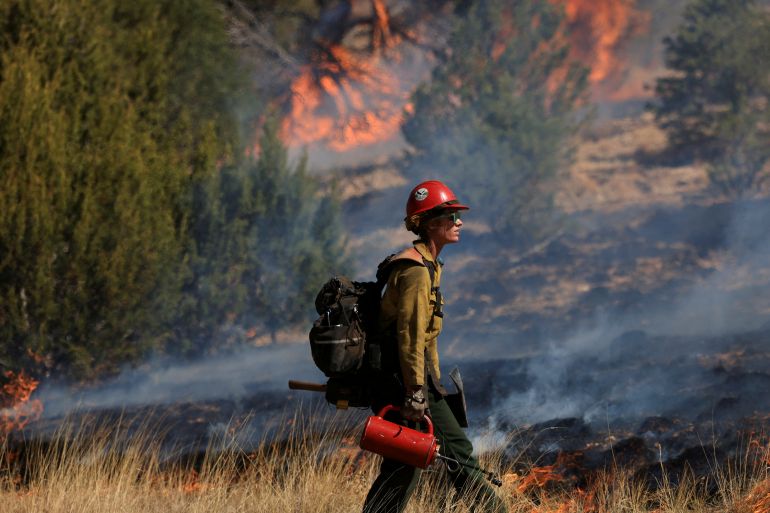Strong winds and high heat expected to fan New Mexico wildfire
Fire officials have bolstered their response by deploying more firefighters and heavy equipment to manage US blaze.

A mix of relentless winds, near-record high temperatures and extremely low humidity in the coming days is expected to further spur a huge fire in the US state of New Mexico that has been raging for more than a month and has already chased thousands from their homes.
United States Forest Service officials said on Friday that starting this weekend, persistent winds of 72km per hour (45 miles/h), high temperatures and low humidity readings are forecast in the three counties where the Calf Canyon Fire has scorched more than 67,987 hectares (168,000 acres).
Keep reading
list of 3 itemsNew Mexico wildfire burns through ‘sacred land’
Photos: US firefighters battle huge wildfires in New Mexico
Fire officials have bolstered their response by deploying more firefighters and heavy equipment to manage the blaze in the event it moves further north, said Todd Abel, a battalion chief with the National Wildfire Coordinating Group.
A series of weather systems will begin to sweep through the fire area on Saturday, he said. “Those systems are probably some of the windiest systems I’ve personally seen and some of the harshest fire-fighting conditions that I’ve seen.”
The biggest active blaze in the US has chased about 10,000 people from their homes and destroyed more than 165 houses in Mora and San Miguel counties since it began on April 6.
It is the most destructive of a dozen blazes in the country’s southwest that scientists say are more widespread and arriving earlier this year due to climate change.
The fire was 20 percent contained on Friday morning as it burned drought-parched vegetation around several centuries-old farming and ranching communities in the Sangre de Cristo Mountains northeast of Santa Fe, New Mexico.
“This is a historic fire weather event … this is a critical stage of the fire,” New Mexico Governor Michelle Lujan Grisham said in a briefing on Friday. “We have high temperatures and extreme wind. This is the worst possible set of conditions for any fire,” she said.
Despite the threatening conditions, more than half the 4,500 residents in Mora County have stayed behind to defend homes that some families have occupied for centuries, even as some run out of food and water, officials said.

US President Joe Biden this week declared a major disaster in New Mexico, unlocking federal resources including financial aid for affected individuals.
Like much of the American West, New Mexico is in the grip of a years-long drought that has left the area parched and vulnerable to wildfire.
Reservoirs have plummeted to dangerously low levels, with Lake Mead – the country’s largest reservoir, close to Las Vegas – at 31 percent.
Scientists say a warming climate, chiefly caused by human activities such as the unchecked burning of fossil fuels, is altering weather patterns.